DON HALL, MIKE STERNER and ROHIT SHUKLA, Fluid Inclusion Technologies, Inc.
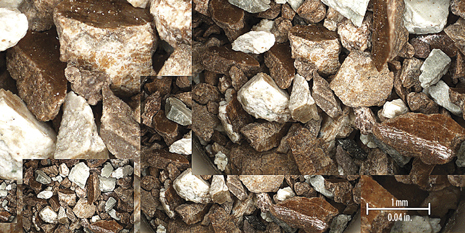 |
| An ultra-high-resolution photographic profile of the borehole lithology recorded from drill chip cuttings. |
|
Exploration and exploitation of increasingly complex reservoirs, along with technical challenges associated with optimizing horizontal wells into tight or unconventional pay sections, benefits from new approaches involving additional data collected in a cost- and time-effective manner. This article describes one such methodology applicable to samples that are historically viewed as containing limited value, namely, unpreserved cuttings. During this procedure, the rock is first photographed under visible and UV light, then crushed and analyzed for included hydrocarbon and non-hydrocarbon species with a sensitive mass spectrometry system, and finally probed for its elemental composition with a customized X-ray fluorescence (XRF) analyzer.
A key aspect of the process is that all analyses are conducted on the same 1-gm rock sample with an automated system, thus preserving interrelationships among rock type, fluid type and rock chemistry. Automation and rapid analytical cycles allow collection of large data sets, and encourage analysis of entire wellbores from first returns to TD. Individually, the techniques are useful. Together they provide unique insights into controls on hydrocarbon, reservoir and pay distribution, represent an additional tool for well placement, and allow organized archival of rock type, fluid and rock chemistry information that is easily retrieved and studied in the context of future wells, even in the absence of the original rock material.
TECHNIQUES
Photography. Washed and dried samples are photographed in white light and under broadband UV excitation with a special, high-resolution imaging system to produce a stratigraphic catalog of every sample submitted for analysis. Ideally, this would represent all samples collected such that a complete record of the penetrated section is available for subsequent study. Grain-scale details of porosity, rock type and texture can be identified. UV images indicate specific mineral fluorescence that can be correlated with cement or rock types that are hard to distinguish under white light. Also, kerogen fluorescence is observable and can be related to thermal maturity when appropriate macerals are identified. Rock fluorescence is unlikely to represent residual oil (unlike similar procedures conducted with fresh samples at the well site), because the samples have been washed and dried and may have been stored.
Images are stored and can be reviewed with a special viewer (see section below). These archived photographs are easier to manage than the samples themselves, are preserved for future use even when original samples have been lost, disposed of or depleted, and allow geologists to study rocks at their desks without relying on sample descriptions or lower quality images from wellsites. These images also can be made available to well site personnel on subsequent wells to aid in sample description and recognition of key stratigraphic markers.
Trapped fluid analysis. Petroleum migration, reservoir charging, and local generation of hydrocarbons from mature source rocks leave trace evidence as fluid inclusions: micron to sub-micron sized sealed fluid-filled cavities in diagenetic cements and healed microfractures.1 Fluid inclusions are not identified during conventional show analysis and are commonly present even in the absence of these classical shows. In addition to migrated fluids, Adsorbed or free-phase volatiles within converted kerogen nanopores can comprise an appreciable component of trapped fluid in mature, organic-rich rocks.2 Destructive bulk analysis of trapped organic and inorganic fluids is accomplished via the Fluid Inclusion Stratigraphy (FIS) technique.3 Samples are crushed in a vacuum system, and liberated fluids are analyzed via direct quadrapole mass spectrometry for C1-C13 petroleum species, and inorganic volatiles (e.g., CO2, H2S, He). Mass spectra and depth profiles of critical species provide a full wellbore profile of trapped fluids that document trapped petroleum distribution within the stratigraphic section, the chemistry of migrated or locally generated petroleum, the location and effectiveness of seals and evidence of proximal charged reservoirs that may not have been penetrated by the borehole. The latter application relies on entrapment of water-soluble organic species such as acetic acid and benzene. These compounds are concentrated in water-bearing intervals within kilometers of petroleum reservoirs, and produce diffusion halos centered on these deposits.4
Within unconventional reservoirs, FIS can infer sweet spots, calculate likely produced-fluid characteristics and help distinguish poor completions from poorly placed laterals. FIS provides a convenient geochemical screening tool for follow-up petrographic and microthermometric work. These techniques help identify specific hydrocarbon charge events, quantitative API gravities, saturation state of hydrocarbon fluid, and salinities for log calculations of water saturation.5
Elemental analysis. XRF of rock material has been shown to have a number of invaluable applications to petroleum exploration, with more recent focus toward unconventional systems.6,7 XRF analyzers determine the chemistry of a sample by measuring the spectrum of the characteristic fluorescence X-rays emitted by the different elements in the sample when it is illuminated by X-rays of sufficient energy. The data provide information that can be related to rock and cement type via computer programs,8 although quantitative analysis also benefits from spot analyses via additional techniques (e.g., XRD, QEMSCAN).9 Historically, chemical stratigraphy via XRF and ICP-MS has been used to correlate monotonous stratigraphic intervals with unclear or variable lateral extent and thickness, particularly in the absence of sufficient biostratigraphic or lithostratigraphic markers. Trends in element abundance and ratios have also been used to infer depositional environment, anoxic events conducive to preservation of organic matter, transgressive vs. regressive cycles and sediment provenance. Empirical correlations can provide semi-quantitative indications of TOC, and elemental summations have been proposed as a means of quickly determining relative brittleness. The latter is relevant to completions. Once delineated from vertical penetrations, key chemostratigraphic markers can be used to steer the wellbore in real time,10 or, in the case of the present method, retrospectively determine or confirm the wellbore path.
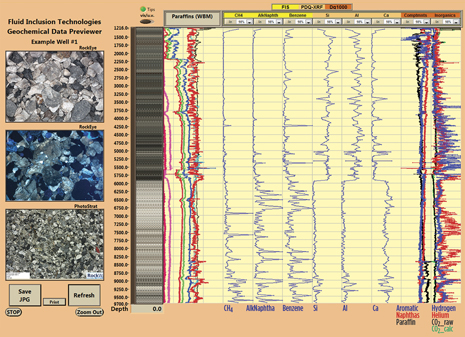 |
| Fig. 1. Static image from an interactive software program that allows mud gas compositions, rock and fluid chemical data, electric logs and rock images to be viewed and manipulated. |
|
Viewer. The results of these three steps are loaded into a viewer that allows the user to rapidly assess relationships among the various image and chemical data sets, Fig. 1. Although not a data analysis tool in the strict sense, the software has virtually no learning curve and is uniquely suited to this specific dataset. LAS files and standard image files are created as well, which are compatible with virtually all other industry programs.
EXAMPLES
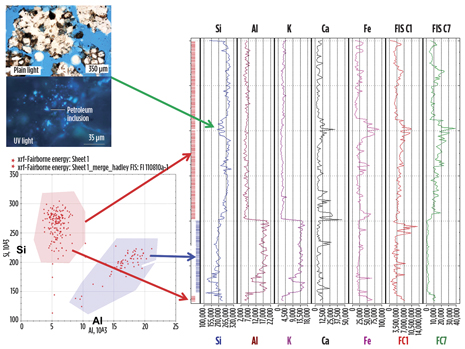 |
| Fig. 2. Selected XRF and FIS data from a horizontal well within Cardium sandstone. Data document a sweet spot which was found to have highest initial production. |
|
Figure 2 shows selected XRF and FIS data from a horizontal well within Cardium sandstone. The wellbore encountered an unexpected fault, and drilled out of section into the overlying shale in the lower part of the well. The transition from sandstone to shale and back again is clearly identified in the XRF data as an increase in Al and K (dominantly related to clay minerals in this case), and a concomitant decrease in Si (reflecting lower bulk quartz percentage). A simple cross plot of Al vs. Si defines the basic rock types here. However, of greater interest is the relationship between Fe, Ca, Si and FIS petroleum indications (represented by C1 and C7). The highlighted interval is characterized by increased Fe and Ca, decreased Si and increased light oil indications in FIS data. Petrographic work indicates that the zone contains increased visible porosity related to the presence of siderite cement. High visible petroleum inclusion abundance is consistent with high petroleum saturation, in this case 42° gravity undersaturated light oil (derived from fluid inclusion petrography and microthermometry). This zone was tested independently and found to be the best producing interval in the wellbore. If laterally continuous, it may represent a target for future wells in the area. FIS acetic acid anomalies are present throughout the well, consistent with the presence of penetrated liquid petroleum charge with probable elevated water saturation.
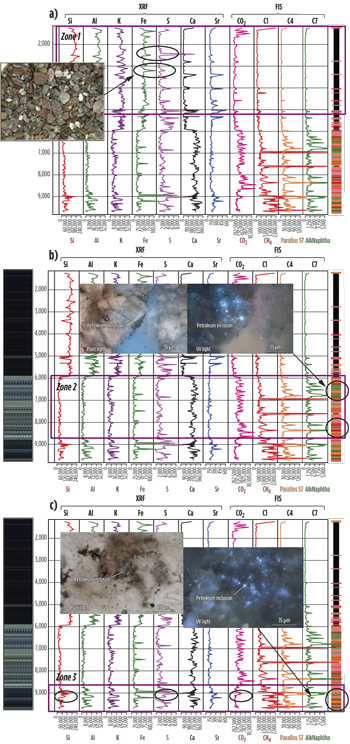 |
| Fig. 3. FIS, XRF and image data from a vertical well illustrating three zones. |
|
Figure 3 illustrates FIS, XRF and compressed image data from a vertical well, along with three zones that will be discussed in more detail. The upper zone is siliciclastic dominated with thin carbonate-enriched intervals, some of which have distinctive UV fluorescence. Two Fe-S anomalies correlate with what appear to be thin red beds or exposure surfaces, as images indicate the presence of hematite-stained rock. Covariance of Ca and Sr is noted in carbonate bearing beds, and, in this well, distinguishes limestone from dolomite. Thin, dry to wet gas FIS anomalies correspond to these carbonate-enriched intervals, and indicate petroleum migration through these zones. Overall, however, the upper section appears to have limited petroleum prospectivity, contains no proximity to pay indications and reported no significant drilling shows. Shallow CO2 is interpreted to be bacterial in origin and is interpreted to have been formed by bacterial sulfate reduction in the presence of vertically seeping light thermogenic hydrocarbons. These FIS microseeps are statistically correlated to deeper liquids potential in many instances, and here are consistent with FIS and mud gas indications of penetrated liquid petroleum deeper in the well.
The middle of the well is carbonate-dominated with little or no covariance of Ca and Sr. The zone is dolomitic, and records UV fluorescence. FIS hydrocarbon indications increase, with the bulk trapped phase varying in character from dry gas to oil. Thin, dry gas zones and decoupled C1 and C7 behavior imply at least two distinct charges, consistent with petrographic work described below. FIS CO2 response is elevated through this zone, but does not covary with hydrocarbons; thus, a separate source (probably diagenetic) is suggested. FIS data suggest the upper and lower thirds of this section have better prospectivity, and petrographic analysis documents the presence of liquid petroleum inclusions in high abundance within these high FIS response zones. High petroleum inclusion abundance implies high oil saturation or paleo-saturation. Moderate to upper-moderate gravity (~30° to low 40° gravity), undersaturated oils are inferred from fluid inclusion relationships, consistent with produced fluids in the area. A dual porosity system is indicated, with intergranular and fracture porosity being significant.
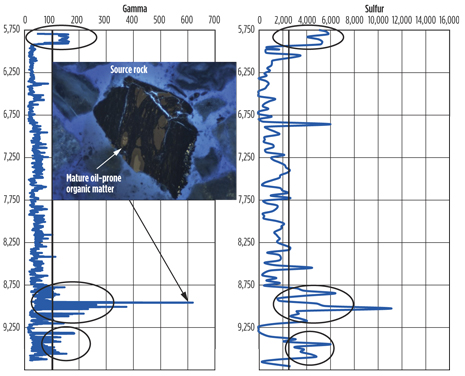 |
| Fig. 4. Correlation of elemental sulfur response with gamma ray response suggests variation in source potential, and correlates with visual organic matter in images and thin section. |
|
The lower section contains mixed siliciclastics and carbonates with some covariance of Ca and Sr consistent with a mixed limestone and dolomite interval. Elemental sulfur response correlates with the gamma ray curve in this zone and throughout this well, Fig. 4, and likely reflects source potential.11 Mature oil-prone kerogen is identified in thin section. A flat to negative Si/Zr profile through the upper portion of this section is consistent with biogenic silica, Fig. 5, in contrast to the generally positive relationship obtained in siliciclastics,12 and phosphorus anomalies are consistent with the presence of apatite in thin section, a near-shore depositional environment with relatively low sedimentation rates and elevated surface productivity.
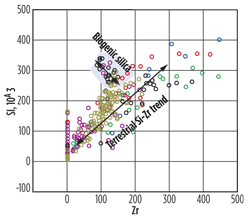 |
| Fig. 5. Cross plot of Zr and Si illustrating the difference between biogenic silica (chert in this case) and terrestrial derived silica (quartz associated with sandstone and siltstone). Sample point colors are grouped according for formation. |
|
The most promising zone, based on FIS response, is at about 9,000 ft, corresponding to a fractured cherty carbonate, which also displayed significant mud gas anomalies while drilling. CO2 covaries with hydrocarbons, and was also recorded in the mud gas, suggesting that some CO2 will be present in the produced petroleum. The source of CO2 and intermittent sulfur species is thought to be related to thermochemical sulfate reduction at high temperature. As it is unlikely that maximum burial temperature at this depth exceeded the threshold for local TSR (about 130oC), influx of mature gas from deeper in the basin is suggested. This is consistent with the presence of discrete dry gas phase in the FIS data. High visible liquid petroleum inclusion abundance is documented here, and suggests high saturation of light oil and gas-condensate in fractured cherty carbonate.
There is evidence from fluid inclusion data that the reservoir contains both gas and condensate or light oil. Lower inclusion abundance and presence of tar-like dead oil deeper in the section represents residual oil. Some of this dead hydrocarbon may have been sourced via gas-deasphaltening during emplacement of the previously mentioned dry, mature gas from depth. Compositional calculations of the bulk FIS volatiles in this lower interval suggest a slightly lighter bulk petroleum phase in the deeper zone as compared to the lower section of the middle interval described above.
CONCLUSIONS
The combination of photography, trapped fluid chemistry and bulk rock elemental analysis has been shown to provide valuable and otherwise unobtainable information with broad application, including present and past petroleum distribution, source and chemistry, rock and cement type, chemical stratigraphy and mineralogical trends necessary for log calculations, depositional environment and likely source rock potential, and rock properties relevant to completion. Data are all collected on a single approximately 1-gm aliquot of washed and dried rock material, with an analytical cycle of four days. Approximately 600 samples per well can be analyzed. Data can be used to help understand petroleum systems in conventional and unconventional reservoirs, and optimize wellbores and completions. 
REFERENCES
1. Hall, D. L., “Fluid Inclusions in Petroleum Systems: A Compendium of Influential Papers,” AAPG Getting Started Series, vol. 15, 2008.
2. Kausik, R., C. C. Minh, L. Zielinski, B. Vissapragada, R. Akkurt, Y. Song, C. Liu, S. Jones and E. Blair, “Characterization of Gas Dynamics in Kerogen Nanopores by NMR,” SPE, Denver, 2011.
3. Hall, D. L., W. Shentwu, S. M. Sterner and P. D. Wagner, “Using fluid inclusions to explore for oil and gas,” Hart’s Petroleum Engineer International, pp. 29–34, 1997.
4. Burtell, S. G., and V. T. Jones, “Benzene content of subsurface brines can indicate proximity of oil, gas,” Oil and Gas Journal, June 3, pp. 59–63, 1996.
5. Munz, I. A., “Petroleum inclusions in sedimentary basins: systematic analytical methods and applications,” Lithos, vol. 55, pp. 195–212, 2001.
6. Hildred, G. V., and C. R. Rice, “Using high resolution chemostratigraphy to determine well-bore pathways in multilateral drilling campaigns: an example from the Horn River Formation, British Columbia, Canada,” Geoconvention 2012: Vision, pp. 1–4, 2012.
7. Ratcliffe, K. T., A. M. Wright and K. Schmidt, “Application of inorganic whole-rock geochemistry to shale resource plays: an example from the Eagle Ford Shale Formation, Texas,” The Sedimentary Record, vol. 10, no. 2, pp. 4–9, 2012.
8. Cohen, D., and C. R. Ward, “SEDNORM – a program to calculate a normative mineralogy for sedimentary rocks based on chemical analyses,” Computers & Geosciences, vol. 17, no. 9, pp. 1235–1253, 1991.
9. Butcher, A. R., “Getting the most out of ditch cuttings: Find out how a new technology is revolutionizing the way we can automatically quantify mineralogy, texture and lithotype on a cutting-by-cutting basis,” Petroleum Exploration Society of Australia, PESA NSW, Sydney, Australia, Sept. 12, 2008.
10. Marsala, A. F., A. M. Loermans, S. Shen, C. Scheibe and R. Zereik, “Real-time mineralogy, lithology and chemostratigraphy while drilling, using portable energy-dispersive X-ray fluorescence,” Saudi Aramco Journal of Technology, Summer issue, p. 18–24, 2011.
11. Berner, R. A., “Sedimentary pyrite formation: an update,” Geochimica et Cosmochmica Acta, vol. 48, pp. 605–615, 1984.
12. Wright, A. M., D. R. Spain and K. T. Ratcliffe, “Application of inorganic whole rock geochemistry to shale resource plays,” CSUG/SPE Paper 137946, Calgary, 2010.
|
The author
DON HALL received BS (1982) and MS (1985) degrees in geology from the University of California at Riverside, and a PhD (1989) in geology from Virginia Tech. He joined Amoco Production Research in 1990 as a research scientist, where he worked on development and implementation of novel fluid inclusion instrumentation and techniques. He left Amoco in 1997 and co-founded Fluid Inclusion Technologies, Inc.
MIKE STERNER has a BS in chemistry from the University of Michigan and a PhD in geology from Virginia Tech. After post-doctoral research positions in Germany and at U.C. Berkley, he joined Pacific Northwest Laboratory where he was involved in thermodynamic modeling of electrolyte solutions. Mike co-founded Fluid Inclusion Technologies, Inc.
ROHIT SHUKLA received his Bachelors in Mechanical Engineering from the University of Mumbai in May 2005, and his Masters in Mechanical Engineering from the Oklahoma State University in December 2007. He started working at FIT in March 2008. |
|








